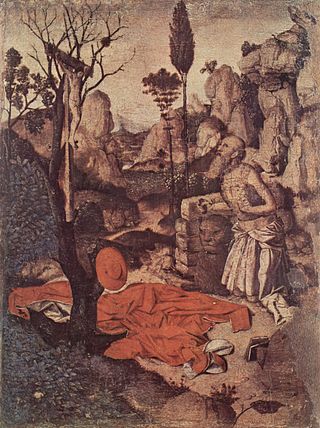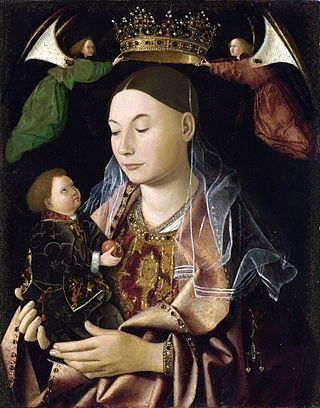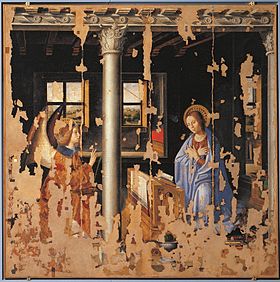Description
The scene is set in a small room with a decorated beamed ceiling, supported by two columns which separate the right half of the painting (with the Virgin) from the left one (with the Angel). The background wall has two windows, with a third in another room visible on the right, according to an iconography derived from the Flemish painting, using different light sources and spatial openings also in interiors.
The objects and the furnitures, as usually in Antonello's works, are finely detailed. They include the Virgin's bed in the background room, the prie-dieu on which she is kneeling, the vase with a blue and white decoration in the foreground (now damaged). Mary has crossed hands while being reached by the dove of the Holy Spirit, sent by God through the opened window. She wears a typical blue mantle above a red dress. The angel, who holds the traditional lily (which is however hidden by a column) and blesses the Virgin, has a rich damask decoration. The face, crowned by long blonde hair, is adorned with a blue diadem, pearls and a ruby, typical details of the Flemish school.
Below is also the figure of a devout, the priest mentioned in the commission contract.

Antonello da Messina, properly Antonello di Giovanni di Antonio, but also called Antonello degli Antoni and Anglicized as Anthony of Messina, was an Italian painter from Messina, active during the Italian Early Renaissance.

Saint Sebastian is a painting, once part of a triptych by the Italian Renaissance artist Antonello da Messina, completed in 1477–1479. It is housed in the Gemäldegalerie Alte Meister, Dresden, Germany.

Saint Jerome in His Study is a painting by the Italian Renaissance master Antonello da Messina. The painting depicts human, natural, and divine knowledge, and is filled with architectural qualities. It was the property of Antonio Pasqualino and afterwards of Thomas Baring, 1st Earl of Northbrook; since 1894 it has been in the collection of the National Gallery, London.

Christ at the Column (Pillory) is a small painting by the Italian Renaissance artist Antonello da Messina, executed c. 1476–1478, showing the Flagellation of Christ. It is in the Louvre in Paris.
Portrait of a Man is the conventional title of several male portraits by the Italian Renaissance artist Antonello da Messina.

The Church of St. Eustache, Paris, is a church in the 1st arrondissement of Paris. The present building was built between 1532 and 1633.

The Crucifixion is the subject of three different paintings by the Italian Renaissance master Antonello da Messina; the first one was completed around 1454/1455, the second and the third in 1475. They are housed in the Brukenthal National Museum ; the Royal Museum of Fine Arts Antwerp and in the National Gallery, respectively.

The Virgin Annunciate is a painting by the Italian Renaissance artist Antonello da Messina, housed in the Palazzo Abatellis, Palermo, region of Sicily, Italy. Probably painted in Sicily in 1476, it shows Mary interrupted at her reading by the Angel of the Annunciation. It is painted in oil on panel, a technique introduced to Italy by its artist, who had learned it from North European artists such as Petrus Christus - by thus abandoning tempera technique he was able to produce the finely-detailed works typical of him.

This article about the development of themes in Italian Renaissance painting is an extension to the article Italian Renaissance painting, for which it provides additional pictures with commentary. The works encompassed are from Giotto in the early 14th century to Michelangelo's Last Judgement of the 1530s.
Ecce Homo is the title of a series of paintings by the Italian Renaissance master Antonello da Messina. They date from 1470 to 1475.

Saint Jerome Penitent and Abraham Served by Three Angels are two paintings by the Italian Renaissance master Antonello da Messina. They are housed in the Pinacoteca Civica, Reggio Calabria.

The Madonna with Child is a painting attributed on basis of style to the early Italian Renaissance master Antonello da Messina, depicting the Madona holding the doll-like Child and wearing an ornate golden crown, held by angels over her head. It is housed in the National Gallery, London. The name Salting, which is also applied to a Madonna by Robert Campin, denotes George Salting, the collector who donated it to the gallery in 1910.

The San Cassiano Altarpiece is a painting by the Italian Renaissance master Antonello da Messina, dating to 1475–1476. Commissioned for the church of San Cassiano in Venice, it was disassembled in the early 17th-century and the reunited central portion is now housed in the Kunsthistorisches Museum in Vienna. It was one of the most influential paintings in the Veneto area of the time.

Lamentation (Pietà) is an oil painting on panel of the common subject of the Lamentation of Christ that is now regarded as by an artist in the "circle" of the Early Netherlandish painter Petrus Christus, rather than by Christus himself. It was painted in c. 1444, and is now in the Louvre in Paris.

Portrait of a Man is an oil painting by the Italian Renaissance artist Antonello da Messina, dated to c. 1475–76, and now in the National Gallery, London. It was printed on the Italian 5,000 lire note issued from 1979 to 1983.

The San Gregorio Polyptych is a tempera-on-wood polyptych painting by the Italian Renaissance master Antonello da Messina, completed in 1473 and housed in the Regional Museum of Messina, Italy.

The Portrait of Giovanni Emo is an oil-on-panel painting by Italian Renaissance artist Giovanni Bellini, executed around 1495–1500. It is housed in the National Gallery of Art at Washington, DC, United States.

The Museo Interdisciplinare Regionale (MuMe). or Regional Museum of Messina (Italian - Museo regionale interdisciplinare di Messina), is an art museum located on the northern coast of the city of Messina, Sicily, Italy. MuMe illustrates the development of art and culture in Messina from the 12th to the 18th centuries, with outstanding figures such as the renowned artists Andrea della Robbia, Antonello da Messina, Girolamo Alibrandi, Caravaggio (Michelangelo Merisi), and Polidoro da Caravaggio.

Calvary is an oil-on-wood painting executed in 1475 by the Italian Renaissance painter Antonello da Messina. Also known as the Antwerp Crucifixion, it is now in the Royal Museum of Fine Arts, Antwerp, making it the only work by the artist in Belgium.

The Sicilian Renaissance forms part of the wider currents of scholarly and artistic development known as the Italian Renaissance. Spreading from the movement's main centres in Florence, Rome and Naples, when Renaissance Classicism reached Sicily it fused with influences from local late medieval and International Gothic art and Flemish painting to form a distinctive hybrid. The 1460s is usually identified as the start of the development of this distinctive Renaissance on the island, marked by the presence of Antonello da Messina, Francesco Laurana and Domenico Gagini, all three of whom influenced each other, sometimes basing their studios in the same city at the same time.
















